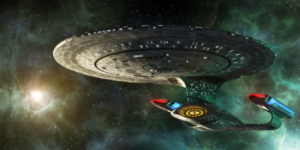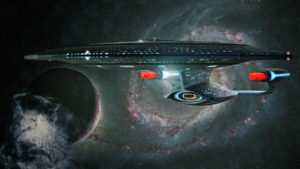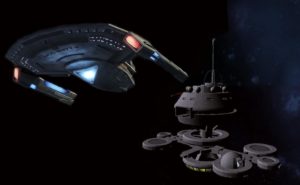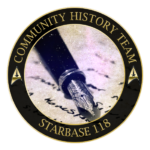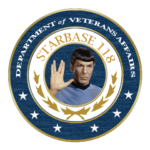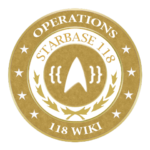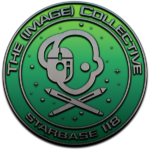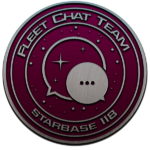Welcome TrekToday readers! Want to learn more about our Star Trek Play-By-Email Role Playing Game? Check out our Prospective Members tour!
As the more hawk-eyed of our members may have noticed, we announced a while back that the publicity team had managed to secure an email interview with none other than Star Trek relaunch novelist, David Mack! It is with great pleasure that we are able to present Mr. Mack’s answers to the questions posed to him by the Starbase 118 Community, and we hope that his insights into writing for the Star Trek universe (and indeed writing in general) will inspire you in your future SIMming! Without further ado, I present: An Interview with David Mack!
Tallis: As a writer for the Star Trek relaunch novels, you write as a member of a team that collaboratively advances the plot for the characters of each branch of the series. How do you meld different people’s visions of the Trek universe, and how can you get the best out of group writing?
David Mack: First of all, I should point out that there is a difference between being an author in a shared universe and “group writing.”
When I write a novel or a piece of short fiction for Star Trek, I am the sole author of that particular work. Although I submit my story—first in outline form and later as a completed manuscript—to my editor and the licensor (the Star Trek office at CBS Television Consumer Products & Licensing) for notes and approvals, I am the sole author of the works I produce. Other authors don’t plot or draft any of the content in any of my works.
That said, there is a high degree of cooperation and coordination between the several authors working on the official Star Trek books. In some cases, the editor serves as the arbiter, referee, and guru with regard to continuity between the books and the canon material and between the books themselves. In other cases, those of us working on books that are part of a shared continuity will contact one another directly and offer notes, feedback on outlines or manuscripts, and other input as requested.
Part of what I love about the Star Trek universe is that, because it has been around for such a long time, and has been so deeply explored and developed, it can encompass a great range of storytelling styles, themes, and content. It has room for wacky, outrageous stories and also introspective character studies; it can present a complex tale of exploration and worldbuilding, or a fast-paced action-adventure; it feels as well-suited to small, slice-of-life short stories as it does to sprawling galactic epics.
Consequently, the many authors who work on the official Star Trek books tend to focus on keeping the details and characters consistent from one story to the next, but we don’t feel a need to change our individual writing styles. As long as the facts and personalities remain consistent, we are each able to bring our own unique approach to storytelling to our respective works.
As for how we do that—a few years ago most of us relied on editorial feedback and the Star Trek Encyclopedia. These days, e-mails and websites such as Memory Alpha and Memory Beta have proved to be the greatest resources at our disposal.
Tallis: How do you go about writing for characters belonging to a species that has had little development in Star Trek canon, for example the Breen?
David Mack: The first thing to remember is that the books and other licensed materials need to be based upon the canon material—the episodes and movies. For that reason, we generally are not allowed to contradict anything from canon, even when the information within canon contradicts itself.
In the case of the Breen, whose biology and culture I explored in my novel Zero Sum Game, the episodes had a lot of different information about the Breen, and previous licensed works, such as role-playing game supplements, had other “official” information that was later contradicted by the shows. Unfortunately, I did not have the luxury of picking and choosing which interpretation was correct—I don’t have that kind of pull within the franchise.
Then I hit upon an interesting idea: what if every canon detail we’ve ever been given about the Breen is 100-percent true and correct? What explanation would be able to reconcile all those different premises from the episodes? The answer I came up with was that “Breen” is not a species but a social construct, a mask for an entire culture that lives in a state of forced anonymity and equality. My inspiration for that concept was fifty percent George Orwell’s dystopian novel 1984, and fifty percent Kurt Vonnegut’s satirical dystopian short story “Harrison Bergeron.”
When it came time to write scenes from the points of view of Breen characters, I imagined what life would look like to people living in such a structured, state-directed society under constant surveillance. I also tried to take into account the variations in perception based on their true, hidden species. Did it affect their perception, senses, predispositions, or preferences?
One curious detail about both the Breen characters whose points of view are depicted in the book is that both are entirely sympathetic characters, even though one of them serves as the hero’s chief enemy. It was also a deliberate choice I made to have the Starfleet main characters act in ways that were most definitely not heroic, as the book was about questioning the moral rationales for war, covert military actions, and state-sanctioned murder.
The ensuing debates between fans about the book, as one might imagine, have been quite lively.
Tallis: What do you consider is the best approach for creating a new species as an antagonist to the Federation without falling into the trap of stereotyping?
David Mack: The answer is the same whether the new species is being created as an enemy, a friend, or even just a backdrop. It must make sense within its environment and within the story. One common mistake is to make every member of the new species identical in opinion, politics, and objectives. How could a species thrive or even function if every one of its members is a mustache-twirling villain? Not everyone is going to agree on everything within a family, so why would an entire alien species have only one outlook on a complex situation or crisis?
Another important thing to keep in mind is that even a seemingly weak species should have some means of survival, or else it would likely have gone extinct a long time ago. By the same logic, even the strongest species should have some kind of flaw or limitation. Nothing gets more boring than godlike aliens who are utterly untouchable and infallible.
For instance, in my Star Trek Destiny trilogy, the race known as the Caeliar seem at first to be demigodlike to the Starfleet characters who meet them. The Caeliar have transitioned from an organic species to one that exists in synthetic bodies composed of supertech particles known as catoms, which replaced their original bodies and brains one atom at a time—taking them from mortal forms to immortal ones with no interruption of consciousness. Now they can turn to vapor and float away, shapeshift, and transmit their consciousness. They never sleep or eat. They can levitate. They have access to amazing technology and nearly limitless energy.
But they are also a stagnant culture. They no longer innovate or create. They are isolationist and too stubborn or fearful to embrace the kind of societal change that might save them. They’re also pacifists who will sacrifice millions of members of their own dwindling population to save a handful of humans from a cataclysm. But they also can rationalize kidnapping and imprisonment without due process in the name of protecting their privacy. Their most serious flaws are overconfidence, naïveté, and a tendency to be slow to react to crises.
Even within this strange species, though, there are iconoclasts. There is Sedín, who is more ruthless than her fellows; Lerxst, who is ashamed of the hypocrisies of his people; and Inyx, a scientist who revels in making contact with outsiders and experiencing new ideas.
All of this came about because I asked myself such questions as:
How did this species get to be what it is now? What do they value? What do they fear? What do they hate? How far will they go to preserve themselves? What does it take to make their society function? Where are they vulnerable?
Tallis: What do you feel are the most important characteristics that should be present in a recurring villain?
David Mack: Complexity and adaptability. A recurring villain can’t be a person with a single goal or two-dimensional motivation.
First and foremost, such a character should never think of himself or herself as a villain. No one ever thinks of oneself as a bad guy; we are all the heroes of our own stories, and some of us are the villains in others’ tales.
Second, the character should have many wants or needs, and even some of those should be mutually exclusive, to add conflict to the villain’s own motives. In other words, there should be times when the villain must choose between achieving Goal A or Goal B, but have no way of accomplishing both, and this should be a fact that the heroes can utilize.
Probably the greatest, most complex, most fully realized recurring villain in all of Star Trek‘s long history is Gul Dukat from Star Trek: Deep Space Nine. He began as a smirking fiend, a Cardassian thug who resented the Bajorans for forcing his people to abandon the occupation of Bajor.
At first, his goal seemed to be to bring back the Cardassian occupation to Bajor and reclaim Deep Space 9 (aka Terok Nor) for himself. But as time went on, he made gains or suffered setbacks in his status within the Cardassian military and government. He developed a disturbing (and very unrequited) attraction to Kira Nerys (and it was later revealed he’d had sex with her mother, who had been forced to work as a “comfort woman” during the occupation, which only made his obsession with Nerys all the more grotesque).
Then, abruptly, his life was turned upside down when his half-Bajoran daughter Tora Ziyal was found alive. He lost his post in the government, got demoted to a low-level ship command, was thrown out of his home by his wife, and found himself cut off from his family and friends. But he willingly suffered these punishments for the sake of his daughter, and for a while he seemed as if he might be a redeemable character. Then he teemed up with the Dominion to get back his power, and he was instrumental in escalating the Dominion’s war against the Federation and its allies.
During this time, his daughter was murdered, and Dukat went completely off the deep end. He sank into madness, let himself be possessed by a Pah-wraith, murdered Jadzia Dax, and finally tried to unleash an apocalypse against Bajor.
Every time you thought you knew what you were dealing with when facing Dukat, he changed the rules. This is how to write a recurring villain: make him complex, and keep the good guys guessing what the villain wants this time.
Tallis: What would you say is the best piece of advice you could give to aspiring writers?
David Mack: Marry someone rich. Failing that, get a degree or certification in some non-writing profession that pays well and has health insurance. Try to find a job that’s very difficult to outsource. Plumber, electrician, carpenter, auto mechanic, refrigeration specialist, lawyer, doctor, that sort of thing.
I’m not kidding.
Here’s the hard, cold truth: 99.9 percent of everyone who dreams of becoming a professional writer will not make it. Of those who do, 99.9 percent will never earn the kind of money that someone like Stephen King or J.K. Rowling or Stephanie Meyer makes. Most of us who work as writers struggle to stay ahead of our bills and live one serious illness or accident away from bankruptcy. A writer is never allowed to miss his or her deadline without penalty, but most publishers will take their own sweet time paying when they owe you money.
This is a brutal business, and it’s not for the starry-eyed dreamers.
If I still haven’t talked you out of it, try to remember these few bits of advice:
- Don’t talk about writing — go write.
- Write some more. Keep writing until you finish what you start.
- Get feedback from someone other than your family, S.O., or close friends.
- Revise your work. Submit it for publication to magazines, publishers, etc.
- Submit each piece of work to only one place at a time; don’t send one story to three places at once.
- Have only one piece on submission at any place at any time; don’t swamp one place with three stories.
- Collect rejection slips and use them to wallpaper your bathroom.
- Send rejected works to new places (one at a time!) until someone buys them.
- Keep writing new things and sending them out, too.
- Keep doing this until something sells. Then do it again.
- Meanwhile, don’t quit your day job.
- Ignore all this advice, go write a bestseller, and prove me wrong.
Finally, remember this: no two writers are likely to tell the same story about how they broke into the business. No two writers ever got their agents the same way. What worked for one person might not work for others. All you can do is write the best words you can and pursue your own path to publication.
And, if you’re one of the lucky ones, in about 20-odd years you, too, will become an “overnight success.”
Good luck!
A huge thankyou to David Mack for taking time out of his busy schedule to answer our interview questions! Thankyou also to the members of the SB118 community who put forward questions, including Lt. Tanjar-Ongra, CPO Radi Rais and Lt. (j.g.) Teagan, as well as the publicity team for voting for the final shortlist of five questions!

